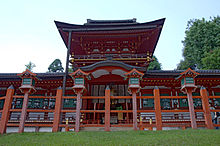
Back Gran santuari de Kasuga Catalan Grandi Santuariu Kasuga Corsican Svatyně Kasuga Czech Kasuga-Taisha German Kasuga-taisha English Kasuga-taisha Spanish Kasuga-taisha Basque کاسوگا-تایشا Persian Kasuga-taisha Finnish Kasuga-taisha French
| Kasuga-taisha 春日大社 | |
|---|---|
 The middle gate and hall Kasuga-taisha | |
| Religion | |
| Affiliation | Shinto |
| Deity | |
| Festival | Kasuga-no-matsuri (Kasuga-sai: 春日祭) (13 March) |
| Type | Twenty-Two Shrines Chokusaisha Beppyo jinja, Shikinaisya Former kanpeitaisha |
| Location | |
| Location | 160 Kasugano-chō, Nara-shi, Nara-ken |
| Geographic coordinates | 34°40′53″N 135°50′54″E / 34.68139°N 135.84833°E |
| Architecture | |
| Architectural style | Kasuga-zukuri |
| Date established | 768 |
| Website | |
| www | |
Kasuga-taisha (春日大社) is a Shinto shrine in Nara, Japan. It was built in 768 CE for the Fujiwara family. It has been rebuilt many times. Inside, it is famous for its bronze and stone lanterns. The shrine's design is called Kasuga-zukuri. It influenced many other religious gates in Japan, called Torii. Kasuga Shrine and the forest nearby are very important historical places and are protected by UNESCO. It is listed as a UNESCO World Heritage Site as part of the "Historic Monuments of Ancient Nara". To get to the shrine, you walk through a deer park. The deer are free and are thought to be holy messengers. The shrine and the deer are shown in many old Japanese paintings. There are over three thousand stone lanterns along the path. There is also a garden next to the shrine.[2]
- ↑ Cite error: The named reference
Tyler-20162was used but no text was provided for refs named (see the help page). - ↑ Birmingham Museum of Art (2010). Birmingham Museum of Art : guide to the collection. [Birmingham, Ala]: Birmingham Museum of Art. p. 46. ISBN 978-1-904832-77-5.
